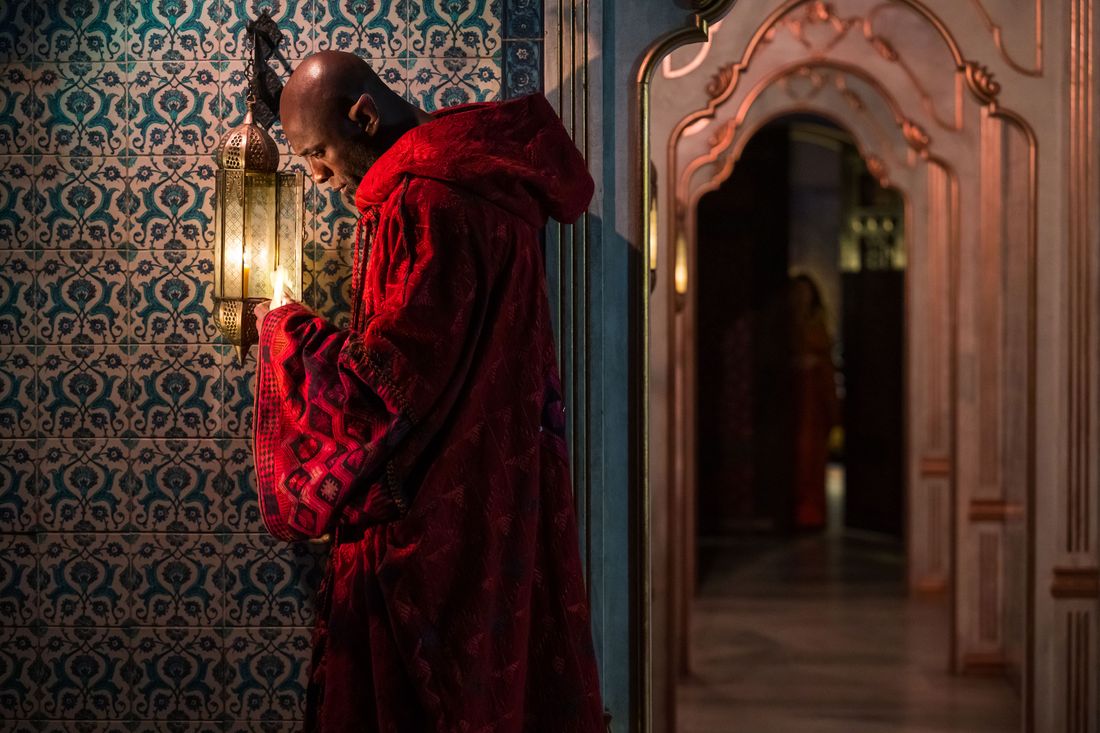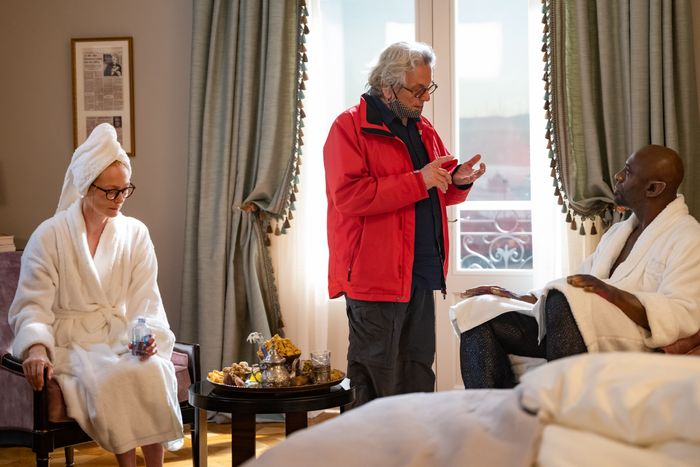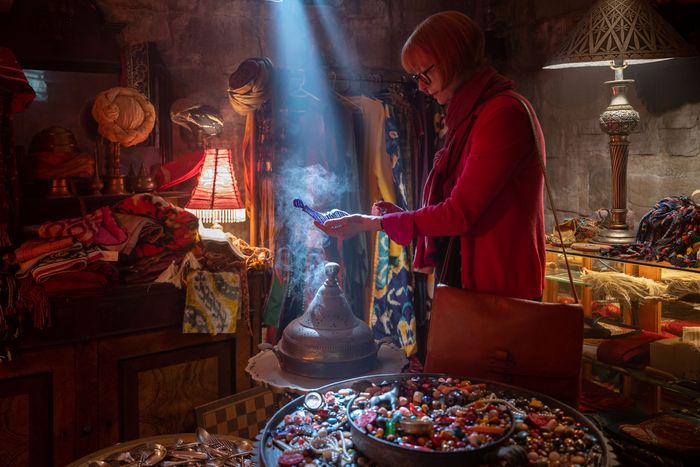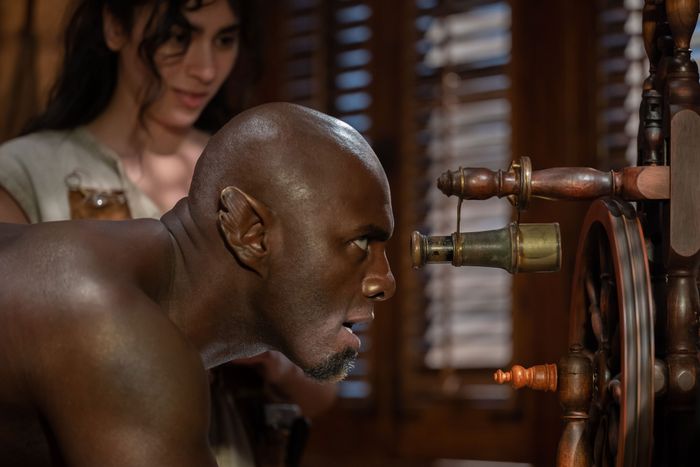
Words and stories have always been profoundly important in George Miller’s films. Despite their terse, post-apocalyptic desolation, the Mad Max movies are filled with myths, references to myths, and scenes of myths being created before our very eyes. In Lorenzo’s Oil, a very ill boy who has been basically paralyzed for much of his life has to express, through the power of a blink, that he wants his mom to stop reading him children’s books and get him started on something more grown-up. In Miller’s worlds, the stories we tell, and the stories we seek, say a lot about who we are as people. His latest film, Three Thousand Years of Longing, adapted from A.S. Byatt’s 1994 story “The Djinn in the Nightingale’s Eye,” feels like a journey to the heart of this obsession. It follows a British narratologist (Tilda Swinton) who, while attending a conference in Istanbul, acquires a glass bottle which houses a djinn (Idris Elba), who in turn tells her a series of interlocking tales about how he got here. And though these tales have the old-fashioned, fable-like charm of something from the Thousand and One Nights, together they form a surprisingly modern (and quietly moving) journey of love and loss.
It feels, frankly, like a statement film. But then again, they’re all statement films. George Miller likes to take his time with his movies; this is only his 11th feature since his directorial debut in 1979. And he’s been working on Three Thousand Years of Longing since the late 1990s, having written the script with his daughter, Augusta Gore. However, this also happens to be an unusually busy time for him. He made this new film, COVID delays and all, right before he got started on Furiosa, his much-anticipated prequel to Mad Max: Fury Road. He zooms into our interview from Sydney, Australia, where he is in the middle of that other production. But frankly, you’d never guess from his mild-mannered demeanor that he’s been spending all his time making what is surely another high-stress, stunt-filled Mad Max movie.
You are currently in the midst of production on Furiosa, but you’re also promoting Three Thousand Years of Longing. Is it weird to step away from the madness of one film to talk about the previous, very different film?
I was worried that the timing of the two films were more or less one on top of the other. But it’s interesting. I’ve often talked to directors who like to do two films at the same time — in particular, the likes of Steven Spielberg and Ridley Scott. As you notice, Steven always seems to have two films on the go. And they say that one is a holiday from the other. It’s kind of a palate cleanser from one film. Because your mind is suddenly on something else, you come back rather refreshed each time.
And it makes a lot of sense to me. One of the most important functions of the director is to keep a kind of dispassionate neutrality to what you’re seeing as the pieces of the film are put together. If you are too euphoric all the time, or if you’re too down, or you’re too immersed, or you’re too particular, or too obsessive about something, you’re not reading what, ultimately, you hope the audience might read.
And you have yourself noted that Three Thousand Years of Longing is, in your words, “the anti–Fury Road.”
Yes. It’s quite the antithesis of Fury Road, for a whole lot of reasons, not only the subject matter, but as you might have seen me say, [Fury Road] happened basically over three days and two nights. This one happens over 3,000 years. That film was outside, very few interiors. This is virtually all set in interiors. There are very few words spoken in Fury Road. This is a lot of words, and so on.
I don’t make many films. So, if you’re going to do it, gee, the worst thing would be to make the same thing all the time. That applies to each individual, and I think that applies to us as audiences. We’re looking for something new. There’s always a cultural evolution, and it’s moving very quickly. Much more quickly than any of us can really grasp, in every way. So there has to be something fresh in you.
This project actually originated in the late 1990s, when you first read A.S. Byatt’s story. Do you ever think about how it might have been different if you’d made it earlier? How does that long period of waiting and working, of setbacks and whatnot, affect the finished film?
I’ve thought about this a lot. We acquired the rights to the A.S. Byatt novella in the late ’90s, I think, ’98, ’99. It took us a while to work on the screenplay, as I have several projects that I go back to. The understanding was that we would make it when it was ready to make. As you evolve the screenplay, it stays in your mind. It’s rather Darwinian. It’s survival of the fittest. Those projects that seem to have more resonance with you individually are the ones that tend to get made. And this one wouldn’t go away.
I would have to say, with all the delays, the biggest thing that impacts films is the advance in technology. For instance, we intended to shoot in Turkey. And as you may have noticed, there’s some wonderful Turkish actors in the film. We spent quite a bit of time in Istanbul. We had all the locations, and all the permission, with really fine production people. Then COVID came, and the film was delayed eight months, and we found that travel was impossible. [If I had tried to make the film years ago] I would have been much more stressed had we had COVID and I learned that we couldn’t shoot in Istanbul. Nowadays, you can go anywhere digitally, as it were. We had to make Istanbul and London in Sydney. There is a scene in the film where Gulten, the slave, looks over a fence. And there, in the garden of Topkapi Palace, is Prince Mustafa, riding a horse. Now that’s the actual garden, at least everything in the background, except for the lawn on which the horse is riding. That would have been much more expensive and difficult to do back in the early 2000s.
But beyond that, as I said, things are always changing. The way we consume moving-image stories, it varies, with lots and lots more platforms. We speed-read films now, so you have to be aware of it. We’ve seen so much more story in the 20 years since we acquired the rights of the film. Tropes are more established, until they become more cliché, and so on. You’re always trying to somehow take that into account.
As you note, the film uses a lot of CGI effects, which I think give it a lovely, picture-book quality. But there was also so much written about how on Fury Road you guys went out and did nearly everything with practical effects that you probably now have this reputation of a filmmaker who does everything “for real.” Some might look at this new film and be disappointed that there’s so much CGI in it.
Again, it’s driven by story. Fury Road was not a film that defied the laws of physics. There weren’t flying vehicles or flying humans, or laser guns, or whatever. In fact, it was very grounded. It was all stuff repurposed, and really old technology. The world was medieval, in a way, so it had to be grounded, and we had to do as much of it for real. However, there was not one shot in that movie that wasn’t CGI in one way or another. We shot over months, but [the story] was compressed in time over three days. Which meant the skies had to remain consistent, so every shot virtually had a changed sky. If you’re driving vehicles across the desert, you’re doing take after take, you’re doing track after track. You had to erase all but the necessary tracks. You were doing stunts with stuntmen, wild stunts, and actors. But there was a redundancy in the cables, where if one cable or harness failed, you had to have another one, so that you could make it as safe as possible. All of those, you had to erase. Landscapes you had to change, if there was some greenery in it, and so on, and so on. In this film, you had to show a djinn reveal that does violate the laws of physics, and you had to find a way to make that play.
You’ve had a number of difficult productions over the years — including a couple of films that didn’t get made. When COVID hit right as you were getting ready to make this one, did you ever think to yourself, Maybe it’s me?
The first film I made was the first Mad Max. At the end of it, and despite it having resonance internationally, I decided that was the last film I was going to make. I just didn’t think I was cut out for it. I found it a bewildering process. All sorts of crazy things went wrong. The weather was not right, so we lost three locations. The leading actor broke a leg about two days before he was to shoot, we had to recut, all sorts of wacky things that tend to happen in film. I remember talking to Peter Weir, who’d already done two feature films. He said, “George, it’s always like that. It’s no different, every single film. You’ve got to think of it as if you’re on patrol in Vietnam. Despite the landmines, the snipers, all those things that can suddenly ambush you, despite all that, you’ve got to complete the mission, and get through intact. And you need that agility.” The moment he said that, it really resonated, and I went on to do other films. Even today, the same thing applies. It’s like that for everybody. I don’t think it ever goes smoothly. It’s like life.
Fury Road was a completed screenplay. We were about to shoot in 2001, just before 9/11. And we didn’t get to shoot it until over a decade later. But the subtext of the film, the undercurrents of the film — not only didn’t seem to change, but the film felt more appropriate to the time as time went on. And there’s a really striking example. In Fury Road, the War Boys, who sacrifice themselves with the hope to go into some Valhalla-like place, they referred to themselves as the Kamakrazee War Boys. So, before the modern jihadist martyr came to the forefront of the public consciousness, that tradition had been in many, many cultures. So those behavior patterns are consistent, I find, in humankind. Because we all have the same neurological template with which we address the world.
What was it like working on a screenplay with your daughter, especially over a lengthy period of time?
I had written Lorenzo’s Oil with a wonderful writer called Nick Enright. Nick was a playwright, and he’d written for television. He was a major teacher at the National Drama School, which gave rise to the Mel Gibsons and the Cate Blanchetts, and so many others. We always wanted to write together again. I said to Nick, “What do you think of this? Would you like to write on it?” We were both in the middle of other things, and we made plans to do that. But in the meantime, he developed a malignant melanoma, which ultimately took his life.
But he also happened to be Gussie’s godfather. And he said to me, “You know who should write this? Gussie.” And it occurred to me that she has all the qualifications. She went to the National Drama School, number one. I have this theory, that the actor and the writer go through a very similar process — the actor on behalf of the character that they play, and the writer on behalf of all the characters. That was one thing. And Gussie was also far more literate than me. It was an opportunity for us to get to know the other parts of ourselves through work. Also, knowing that it would take as long as it needed to. So, we’d both be doing other things and come back to it.
There’s something that I’ve noticed in all your films. When your characters speak, you’re not afraid to have them talk in an almost poetic, mythical style. It feels like something out of Melville or Shakespeare. This is true even in Fury Road, even though Max barely says a word. But when people do talk, it’s this very heightened form of speech that I find wonderful, and quite rare in films today. Is that something you consciously work on when you’re writing a script?
Well, to be honest, it comes out of the story. In the Mad Max world, everything that existed was made from found objects. Not only the vehicles, the utensils, the clothing, but also the language was made from found objects. You can’t use modern colloquialisms. If you swear, and people use the F-word or, “Oh my God,” or something like that, it puts you very much in the modern world. You had to avoid all that in the Mad Max world. That was deliberate in the writing. So it is with a film like this. You have a discourse between a djinn, who’s been around, who speaks several languages. He learns languages very quickly. And he’s talking with somebody who is a scholar of stories across time. So naturally, they would converse in that kind of language. They both speak Aramaic, ancient Greek, he speaks Ottoman Turkish.
But it seems like something you’re specifically drawn to. Even Lorenzo’s Oil has that very heightened, almost operatic quality of language. Why do you think you’re drawn to that kind of speech?
No one’s mentioned that before, but I think you’re right. Lorenzo’s Oil was as close to the real events as I imagined that one could do a film. We were very scrupulous about that. It happened that the real events of that story tended to follow the template of the hero myth. But once again, you had two people, who, in real life, were very articulate in the conversations they had together. From two different cultures, they came together. But for both the Odones, Michaela and Augusto, that’s who they were in real life. Some of it’s verbatim the way they spoke. You’re the first to ever mention it. I really do suspect it’s the nature of stories, because all of those stories, in their own way, fall into Joseph Campbell’s pattern of the monomyth one way or another — even, indeed, the Babe movies, or the Happy Feet movies.
Do you feel that there is a healing power in the act of telling stories?
I think that stories have healing power. They also have destructive power. I’ve often thought that stories should often come with that sign they put on radiation, “Hazardous Material.” Not that stories can’t be dark and confronting, but for a story to be worth itself, to somehow mean something, it has to have something nourishing, or at least help you process through something. Stephen King points out that horror stories and horror movies are basically what he calls dress rehearsals for termination. You go through a process where you viscerally engage with the film, and then you come out the other end having confronted the darkest places. There’s something useful in that. It’s like a roller-coaster ride. You go down the roller coaster, but you know that the engineering is such that you’ll come out the other end intact. Or that’s the hope. But you at least get that experience. It’s one of the essential functions of stories. We are hardwired for that, right through our evolution.
Go back to our fairy stories that we tell each other as children, in whatever culture. They always have something that helps you process something that you’re confronted with. How else do you deal with an issue of abandonment by your parents than through the allegory of Hansel and Gretel? An ineffective, weak father and a hostile stepmother basically try to get rid of Hansel and Gretel. They endure, and they go into very dark places, temptation, gingerbread house, having to kill a witch by trickery, and then find their way back. We as children want those stories, over and over again, until we process whatever it is that we have anxiety about. I think that’s the function of story. You’ve got to have a sense of that as a storyteller. And you can’t often tell what the story means to people. No story should be a closed narrative, or tell you what to feel or what to think. You take it from the experience of the story.
A.S. Byatt is not only an important literary figure, she’s also a great scholar. And she’s a big champion for narrative. At the turn of the millennium, just about the time that I read her story, the New York Times asked a number of people to write, “What’s the best of the millennium? What’s the best music, what’s the best architecture?” She was asked to write on literature, and she wrote a piece called “Narrate or Die.” It was specifically about the Arabian Nights, or the Thousand and One Nights, being the most significant stories of the millennium. She pointed out that these were stories that evolved over hundreds of years, across many, many cultures, from Asia, all the way down to Spain, along the trade routes. Before television, or the internet, before wholesale literacy, people got their stories basically orally. On those routes, there were the coffee lounges and the inns, where there was always a storyteller to entertain people. Those stories evolved and changed across those trade routes over many centuries. The storytellers had to be highly skilled, because they always had to fill their stories with suspense — just as Scheherazade had to do, to stay alive. And the best of them would be followed out into the street by the people wanting to know what happened next. They would say, “Come back tomorrow night, and I’ll tell you.” And that’s how those stories evolve.
It’s a little bit like when we binge-watch. You have to watch the next. It’s the skill of the storyteller to keep the audience coming back. And there’s lots and lots of techniques. Lots of stories build to a moment of suspense and say, “Look, before I tell you what happened next, I’ll tell you something else about the other character.” You build up, you withhold the denouement of the story, until people just have to switch it on again. [Byatt] pointed that out, and you see it. And she said [the Thousand and One Nights contained] the first ironic jokes. They were the first dirty jokes. There was one about the world’s loudest fart.
Whenever I’m back in Turkey, I’m surprised at how fresh in the mind stories of myth and legend are, as well as history. You’ll be talking with someone, anyone, and they’ll reference the Thousand and One Nights, or the Greek myths, or a piece of historic folklore. Your film has that quality as well — this sense that the stories of the past, however fanciful, are still present. It’s quite an old-fashioned idea in some senses. And sometimes, especially in the west, we tend to look down on stories like these as exoticized, or simplistic, or out of touch. Did you ever worry about that?
That’s who we are as human beings. My background is Greek. My mother was born in Izmir, just short of a century ago. She passed away two years ago; she was lucky enough to see her hundredth year. And she left there when she was 2. When I went to Greece, what struck me was that, particularly not in the cities, whatever other stories they told, they told stories of real-life people who had been dead a century, as if they knew them personally. They talked about a certain person, or a priest, who was so vivid in the collective memory.
I didn’t go back to where my parents came from until I was well into adulthood. But I was also lucky enough to grow up in remote Australia. And I got to know a lot of the Indigenous cultures in the areas where I was. We’re talking about the oldest extant continuous culture on the planet, probably going back 40,000 to 70,000 years ago. And some of it is still existing. It’s continuous. It’s oral history. They call it songlines, particularly desert Australians. In one particular case, where we spent some time with an elder and his family, they told a story of the region they were about. There was a mountain where there was water, where there were rock formations, where there were all these features — including, by the way, the stars and the constellations. They had fashioned a story which explained it all, almost like a GPS map. And not only that, it had pedagogic learning in it. The time I spent there was with an old man, who told us the story through a translator. One of his daughters was there with his grandchildren. They were from the big city, Adelaide, and she wore a T-shirt with Spider-Man on it, and the kids were playing with my kids. And here we were, being told stories that were well over 8,000 years old, that were still being told within their community today. I remember asking this woman from the city, with the Spider-Man T-shirt, about the story that her father had told. She said, “Yes, there’s a lot of learning in that story, just as there is in the stories that I tell my kids in the modern city. That process is continuous.” The very thing you are talking about I think is not only to be cherished, I think it’s the essence of who we are. It’s what we do to each other, one way or another. It’s how we engage and share meaning.
I went to medical school with my twin brother, and today, he’s about to retire after 50 years in practice. He’s the most wonderful raconteur. And most of his stories are about patients or families he knew. And they are so vivid, and so funny, and so profound, that I’ve asked him to write them down. Because that’s the way he involves me and engages me in the work that he’s been doing all this time. It’s what we do, whoever we are. The most powerful of those stories, I believe, are the scientific narratives, as Alithea says in the film, which make a bewildering world coherent. That’s why I’m here at my age, still trying to figure out what that process is. Not only how to tell stories, but why is it that we always have, and always will, need stories to find shared meaning? It’s the only way we can do it, whether they’re religious stories, or popular superhero movies, or stories we tell someone that we meet at a bus stop. It’s a kind of a glue that we can’t do without.
More From This Series
- Paul W.S. Anderson on Getting Lost in George R.R. Martin’s World
- A Night Out With the Strippers of Sean Baker’s Anora
- ‘You’re Not Thinking About the Film. You’re Filming to Survive.’





